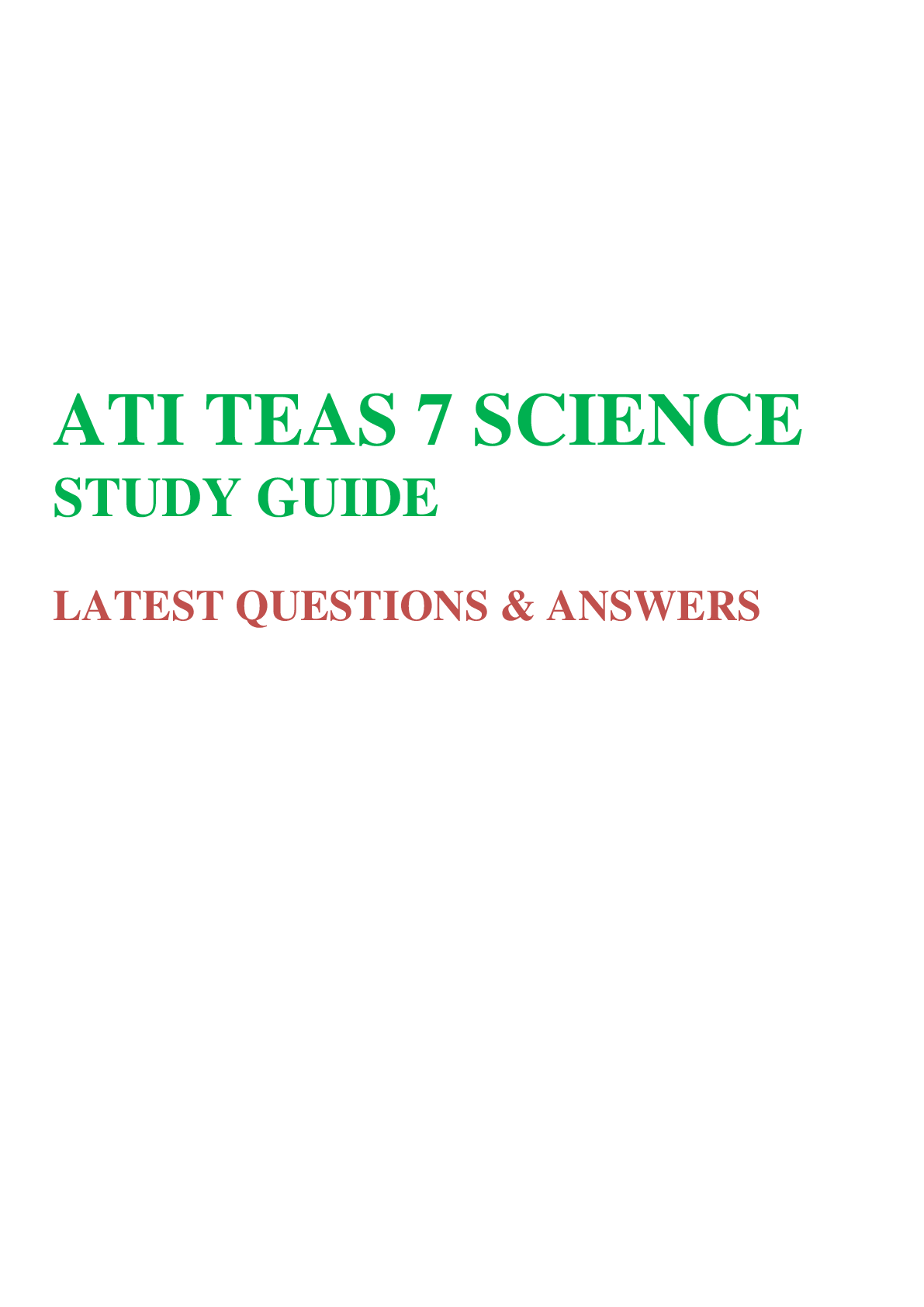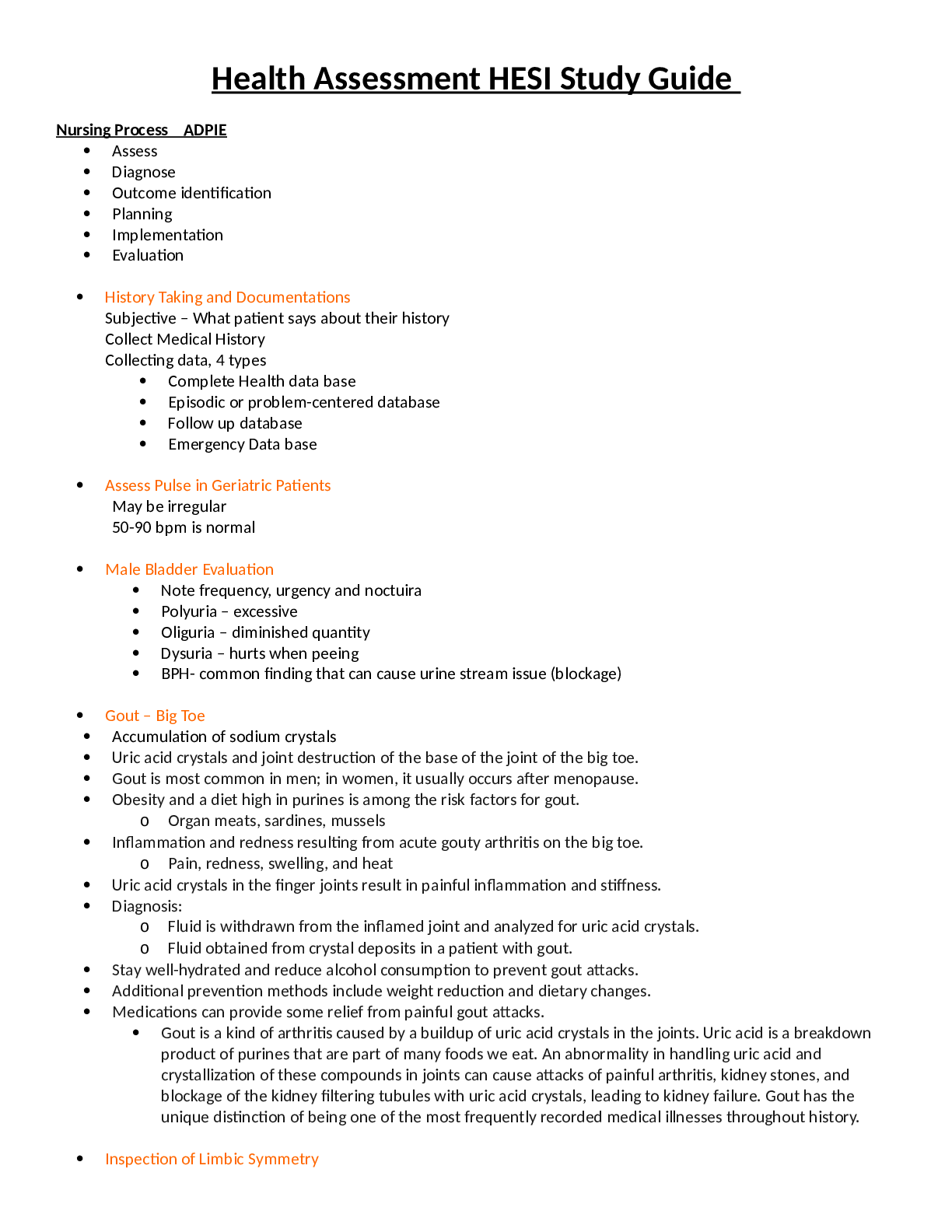*NURSING > STUDY GUIDE > MEDSURG 2 HESI Study Guide Questions & Answers Complete (All)
MEDSURG 2 HESI Study Guide Questions & Answers Complete
Document Content and Description Below
HESI Med/Surg 2 Study Guide With Answers Musculoskeletal Care of patient with a fracture • Types- a) Closed/simple- skin over the fractured area remains intact b) Comminuted- bone is splintered or c... rushed, creating numerous fragments. c) Complete- bone is separated completely by a break into 2 parts. d) Compression- a fractured bone is compressed by other bone e) Depressed- bone fragments are driven inward. f) Greenstick- one side of the bone id broken and the other is bent; these fractures occur most commonly in children g) Impacted- a part of the fractured bone is driven onto another bone. h) Incomplete- fracture line does not extend through the full transverse width of the bone. i) Oblique- the fracture line runs at an angle across the axis of the bone j) Open/compound- bone is exposed to air through a break in the skin; soft tissue injury and infection are common. k) Pathological- fracture results from weakening of the bone structure by pathological processes such as neoplasia; also called spontaneous fracture. l) Spiral- break partially encircles bone m) Transverse- bone is fractured straight across • Assess for a) Pain or tenderness b) Decrease or loss of muscular strength or function c) Obvious deformity d) Crepitation, erythema, edema, or bruising e) Muscle spasm and neurovascular impairment • Nursing Interventions a) Immobilize affected extremity b) Assess neurovascular checks c) Reduction, fixation, traction, or cast • Complications a) Fat embolism- originates from bone marrow; long bone fractures are at greatest risk; can occur within the 1st 48-72 hrs b) Avascular Necrosis- occurs when fracture interrupts the blood supply to a section of bone, leading to bone death; notify MD immediately c) Compartment Syndrome- ↑ pressure that ↓ blood flow; assess neurovascular checks; notify MD immediately d) Infection and Osteomyelitis e) Pulmonary Embolism Skin Color Skin temperature Movement Sensation Pulses Capillary Refill Pain Rheumatoid arthritis/Osteoarthritis OA-involves the formation of new joint tissue in response to cartilage destruction. Not a normal part of aging. The pathogenesis is complex, metabolic, and local factors that interact wand cause a process of cartilage deterioration. RA-Chronic, systemic autoimmune disease characterized by inflammation of connective tissue in synovial (disarthrodial) joints. Characterized by periods of remission and exacerbation. Can occur at any time in life. Assessment: (signs and symptoms) 1. OA-Heberden’s and Bouchard’s nodes are red, swollen, and tender. 2. RA-fatique, weight loss, anorexia, generalized stiffness. Diagnosing Tools (tests or lab values) 1. MRI 2. CT scan/X-ray 3. ESR, ANA titers, CRP Collaborative Treatment: (e.g. medical or surgical) 1. Treatment with splint and braces, ROM 2. Heat and cold applications (OA) whirlpools, US, paraffin wax baths 3. Acupuncture (alternative therapy OA), PT/OT Drugs: 1. NSAIDS (both) glucosamine and chondroitin 2. RA (DMARD therapy with Rheumatrex) 3. Corticosteroids, intraarticular injections (RA) Nursing Interventions: Pain management, splints, cold application, TAI chi PT/OT referral for assistive devices 3. Administer medications as prescribed, teach about any side effects 4. Encourage stress management Teaching: 1. Pt should take meds per MD order 2. Follow prescribed diet, weight management 3. Assistive devices, grab bars, night lights (safety precautions) Acute and chronic kidney disease- symptoms, signs, lab values, causes, diet, management -signs/sx of hyperkalemia, foods high in potassium What would you teach a patient with Carpal tunnel? pg 1509 • Definition- caused by compression of the median nerve, which enter the hand through the narrow confines of the carpal tunnel. • Interventions a) Identify risk factors- women, people with DM, PVD, Rheumatoid arthritis b) Adaptive devices such as wrist splints may be worn at noc to hold the wrist in a slight extension and relieve pressure on the median nerve. c) Use special keyboard pad and mouse d) Frequent work breaks, workstation modifications, and change in body positions e) Relieve underlying cause f) Physical therapy g) Corticosteroids injections may relieve (surgery suggested after 6 months of tx if no relief) Outpatient. h) Surgery What is the priority to assess in a patient with an external fixation device? (distal perfusion, pin sites, infection) What is the priority when caring for a patient with osteomalacia? pg. 1553 **Administering Vitamin D supplements Renal • Acute renal failure- (hyperkalemia/hyponatremia) pg. 1101 a) Symptoms- oliguria, ↓ blood flow, metabolic acidosis, diuresis, impaired kidney function b) Diet- Na, K, and fluid restriction, adequate protein intake (calcium will normal all other labs will be elevated) c) lab results- increased BUN, creatinine, abnormal urinalysis Na and K d) causes- Hypovolemia, ↓CO, nephrotoxic drugs, BPH, trauma, ↓ blood flow e) teaching- identify cause and correct it, I&O, IV fluids, regular insulin, dialysis, monitor electrolytes especially K • Chronic renal failure- pg 1107 a) Symptoms and labs- uremia, ↑BUN and creatinine, electrolytes may be elevated especially K and Na, anemia, metabolic acidosis, HTN, FVE or FVD b) Diet- (Low protein, low K) c) lab results, d) causes- DM, HTN, glomerulonephritis, cystic diesases, urologic diseases e) teaching- correct problem, prevent complications, support ct, control HTN anemia and fluid & electrolyte imbalance, dialysis Glomerulonephritis - symptoms, diet, lab results, causes, teaching Glomerulonephritis is inflammation of the glomeruli and causes Nephrotic syndrome which results from the glomerulus being excessively permeable to plasm protein, causing proteinuria that leads to low plasma albumin and tissue edema. R/T strep infection. S/S: flank pain, HTN, periorbital edema, cola-colored urine (frothy) s/s hematuria Monitor kidney function, ability to filter, and labs- BUN, creatinine, UA Treatment: antibiotics, corticosteroids, reduce edema, salt/K/protein restrictions, dialysis and transplantation if needed, daily weights, monitor I&O, bedrest, Hemodialysis -What would you do for a dialysis patient who develops hypotension? **Give fluids Hemodialysis - A medical procedure to remove fluid and waste products from the blood and to correct electrolyte imbalances. This is accomplished using a machine and a dialyzer, also referred to as an "artificial kidney." Hemodialysis is used to treat both acute (temporary) and chronic (permanent) kidney failure. Peritoneal dialysis - is a treatment for patients with severe chronic kidney disease. The process uses the patient's peritoneum in the abdomen as a membrane across which fluids and dissolved substances (electrolytes, urea, glucose, albumin , osmotically active particles ,and other small molecules) are exchanged from the blood. Fluid is introduced through a permanent tube in the abdomen and flushed out either every night while the patient sleeps (automatic peritoneal dialysis) or via regular exchanges throughout the day (continuous ambulatory peritoneal dialysis). PD is used as an alternative to hemodialysis though it is far less commonly used in many countries, such as the United States. It has comparable risks but is significantly less costly in most parts of the world, with the primary advantage being the ability to undertake treatment without visiting a medical facility. The primary complication of PD is infection due to the presence of a permanent tube in the abdomen What are the priorities of care for a patient after a nephrectomy? pg. 1095 • Adequate ventilation- turn, cough, deep breathe; IS, early ambulation • Urine output- monitor- I&O, observe color, and amount of drainage, observe dressing, weigh pt. daily • Abdominal distention- NPO until bowel sounds return, IV fluids, monitor for paralytic ileus Urolithiasis - lithotripsy ****a treatment, typically using ultrasound shock waves, by which a kidney stone or other calculus is broken into small particles that can be passed out by the body. GI ***GI Bleed, coffee grounds emesis S/S: melena (liguid consistency), tarry stools (sticky) or hematemesis Prontix/Pantoprazole is a Proton Pump Inhibitor used to treat GERD. It decreases the secretion of acid in the GI tract. Teach patients to avoid NSAIDs, such as (Ibuprofen, Aleve Motrin, Midal) ect. .alcohol, (including mouth washes and smoking p. 954What are some potential causes of GI bleeding? Hepatic causes? Immune/hematologic causes? Cirrhosis of the liver, PUD, ASA, ** pg. 954Esophageal varices -what foods would be contraindicated? Coffee S/S: melena and hematemesis Diagnostic test: endoscopy This is a complication of cirrhosis, and can also be seen in bulimic patients as well. Massive hemorrhage is a medical emergency (airway management/blood transfusion) Foods:: Colon cancer Bowel obstruction treatment? Polyps What is traveler’s diarrhea? How is it prevented? pg. 957 Caused by drinking water while overseas, must drink bottle water. Antibiotic Loperamide (Imodium). Do not use loperamide if patient has a fever or blood in the stool. Causing bacteria: E. coli, Shigella, Salmonella, Campylobacter Integument pg. 436/pg 119 What is Shingles? What causes it? What are some long term complications? How are they treated? Teaching for a patient with eczema? No milk,eggs, citrus fruits, atopic dermatitis, Don;t use soaps, no wool/wear cotton, avoid excessive bathing, tepid water bathing, keep nails short et clean. What would you teach a patient undergoing radiation therapy about skin? pg. 270 Avoid sun Priorities for burn victims pg. 450 • Maintain airway, Fluid replacement for 1st 24 hrs; other s/s- pain, and Hypoxia (priority), prevent infection • Use cool water to stop burning process, remove jewelry, remove burned clothing and cover with dry cloth, assess for airway injury and acidosis Skin changes in muscular dystrophy? pg. 1544 • Limit sedentary periods to prevent skin breakdown and respiratory complications • Prolonged bed rest should be avoided to prevent skin breakdown Immune/Hematology pg. 1582 What is SLE? What symptoms occur? How is it treated? Nephritis?-contracts in 40% in 5-years Multisystem inflammatory autoimmune disease/fever, wt. loss, arthralgia, excessive fatique Treatment for restless leg syndrome? pg. 1427 ↓ pt. discomfort and distress • Improve sleep quality and establish regular sleep habits • Treat underlying cause (anemia) • Exercise, avoid activities that cause s/s • Eliminate factors like alcohol, caffeine, and certain drugs (neurolytics, lithium, antihistamines, antidepressants) • Drugs: dopamine precursors (Sinemet, Requip, Mirapex to ↑ amount of dopamine in brain. Antiseizure, opioids, benzodiazepines What specific food allergies are important to report in a pre-operative patient? Shrimp, Iodine, Bananas, Avocado, chestnut, kiwi, tomatoes, guava, potatoes, grapes and apricots, pg. 216 Blood transfusion reaction process Lewis 676-77] -It should be documented in the patient’s chart that the physician has discussed the risks, benefits, and alternatives with the patient prior to beginning transfusion therapy -Administer with at least a 19-gauge needle, cannula, or catheter. Larger sizes (e.g. 18 or 16 gauge) may be preferred if rapid transfusions are given. Smaller needles can be used for platelets, albumin, and clotting factor replacement -Verify venous access patency -Most blood product administration tubing is of a “Y type” with a microaggregate filter (filters out particulate) with one arm of the tubing for isotonic saline solution and the other arm for the blood -Do not use dextrose solutions or lactated Ringer’s solution for administering blood because they will cause RBC hemolysis -Do not give any additives (including medications) via the same tubing as the blood unless the tubing is first cleared with saline solution -Make a positive identification of the donor blood and recipient with a dual-checking system involving two licensed individuals checking the identification of the patient with the labeled blood component -Patient may be premedicated with an antihistamine (e.g. Benadryl) and hydrocortisone to decrease the possibility of reacting to platelet transfusuons -Take vital signs before beginning. If the patient has abnormal vitals, call the physician to clarify when the blood may be administered -Administer the blood as soon as it is brought to the patient. Do not refrigerate it on the unit. -If the blood is not used within 30 minutes, return it to the blood bank -During the first 15 minutes or 50 mL of the infusion, remain with the patient. The rate during this period should be no more than 2 mL/min. -Do not infuse PRBCs quickly except in an emergency. Other blood components, such as FFP and platelets, may be infused over 15-30 minutes -After the first 15 minutes, retake vitals and determine rate of infusion based on the patient’s clinical condition and product being infused. -Observe patient every 30 minutes during the infusion and up to 1 hour after the infusion. -Transfusion should not take more than 4 hours. -Blood that is unrefrigerated for 4 hours or longer should not be infused and should be returned back to the blood bank Type of Reaction Cause Manifestations Acute Acute hemolytic reaction Infusion of ABO incompatible whole blood, RBCs, or components; Antibodies attach to antigens causing RBC destruction Usually develop within first 15 minutes. Chills, fever, LBP, flushing, tachycardia, dyspnea, tachypnea, hypotension, vascular collapse, hemoglobinuria, acute jaundice, dark urine, bleeding, acute kidney injury, shock, cardiac arrest, DIC, death Febrile, nonhemolytic reaction (most common) Sensitization to donor WBCs, platelets, or plasma proteins Sudden chills, rigors, and fever, headache, flushing, anxiety, vomiting, muscle pain Mild allergic reaction Sensitivity to foreign plasma proteins Flushing, itching, pruritus, urticarial Anaphylactic and severe allergic reaction Sensitivity to donor plasma proteins Anxiety, urticarial, dyspnea, wheezing, progressing to cyanosis, bronchospasm, hypotension, shock, and cardiac arrest Circulatory overload reaction Fluid administered faster than the circulation can accommodate; People with cardiac or renal disease at risk Cough, dyspnea, pulmonary congestion, adventitious breath sounds, headache, HTN, tachycardia, JVD Sepsis reaction Transfusion of bacterially infected blood components Rapid onset of chills, high fever, vomiting, diarrhea, marked hypotension, shock Transfusion-related acute lung injury (TRALI) reaction Reaction between transfused antileukocyte antibodies and recipient’s leukocytes Noncardiogenic pulmonary edema, fever, hypotension, tachypnea, frothy sputum, dyspnea, hypoxemia, respiratory failure Massive blood transfusion reaction Can occur when replacement of RBCs or blood exceed total blood volume within 24 hours Hypothermia and cardiac dysrhythmias, citrate toxicity and hypocalcemia, muscle tremors, ECG changes, hyperkalemia, diarrhea, paresthesias, paralysis of muscles, cardiac arrest Delayed Delayed hemolytic reaction Result of destruction of transfused RBCs by alloantibodies not detected during crossmatch Fever, mild jaundice, decreased hemoglobin. Occurs about 5-10 days posttransfusion Hepatitis B From contaminated donated blood Elevated liver enzymes (AST and ALT), anorexia, malaise, nausea, vomiting, fever, dark urine, jaundice Hepatitis C From contaminated donated blood Similar to hepatitis B, but symptoms are usually less severe. Chronic liver disease and cirrhosis may develop Iron overload Excess iron is deposited in heart, liver, pancreas, and joints Heart failure, dysrhythmias, impaired thyroid and gonadal function, diabetes, arthritis, and cirrhosis Anemia -what foods are iron rich? pg. 637 Liver, et muscle meats, eggs, dried fruit, breads et cereals, legumes, potatoes, vegetables K-rich foods. pg 1115 Neuro Priorities for stroke pg. 1388/1412 What is expressive aphasia? What interventions may help a patient with expressive aphasia? pg. 1394 What are priorities for a patient with meningitis? What type of isolation does it require? pg. 1383 Droplet precautions, private room. Priorities for a patient with MS? Safety, fall risk, aspiration, rest, elimination How does ALS affect respiratory status? Seizures (teaching care) Chronic back pain Priorities for spinal cord injury [Show More]
Last updated: 1 year ago
Preview 1 out of 25 pages
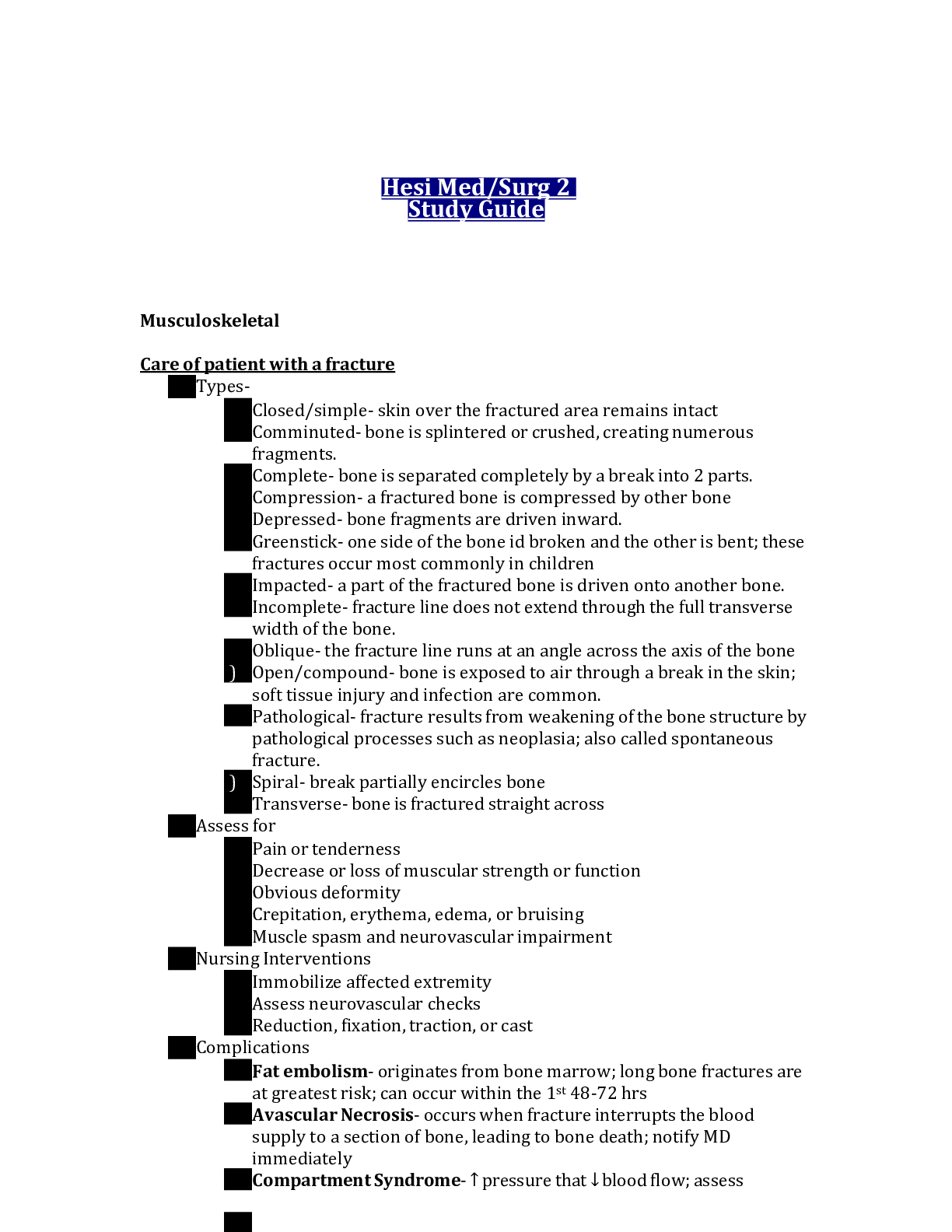
Reviews( 0 )
Document information
Connected school, study & course
About the document
Uploaded On
Apr 21, 2021
Number of pages
25
Written in
Additional information
This document has been written for:
Uploaded
Apr 21, 2021
Downloads
0
Views
84


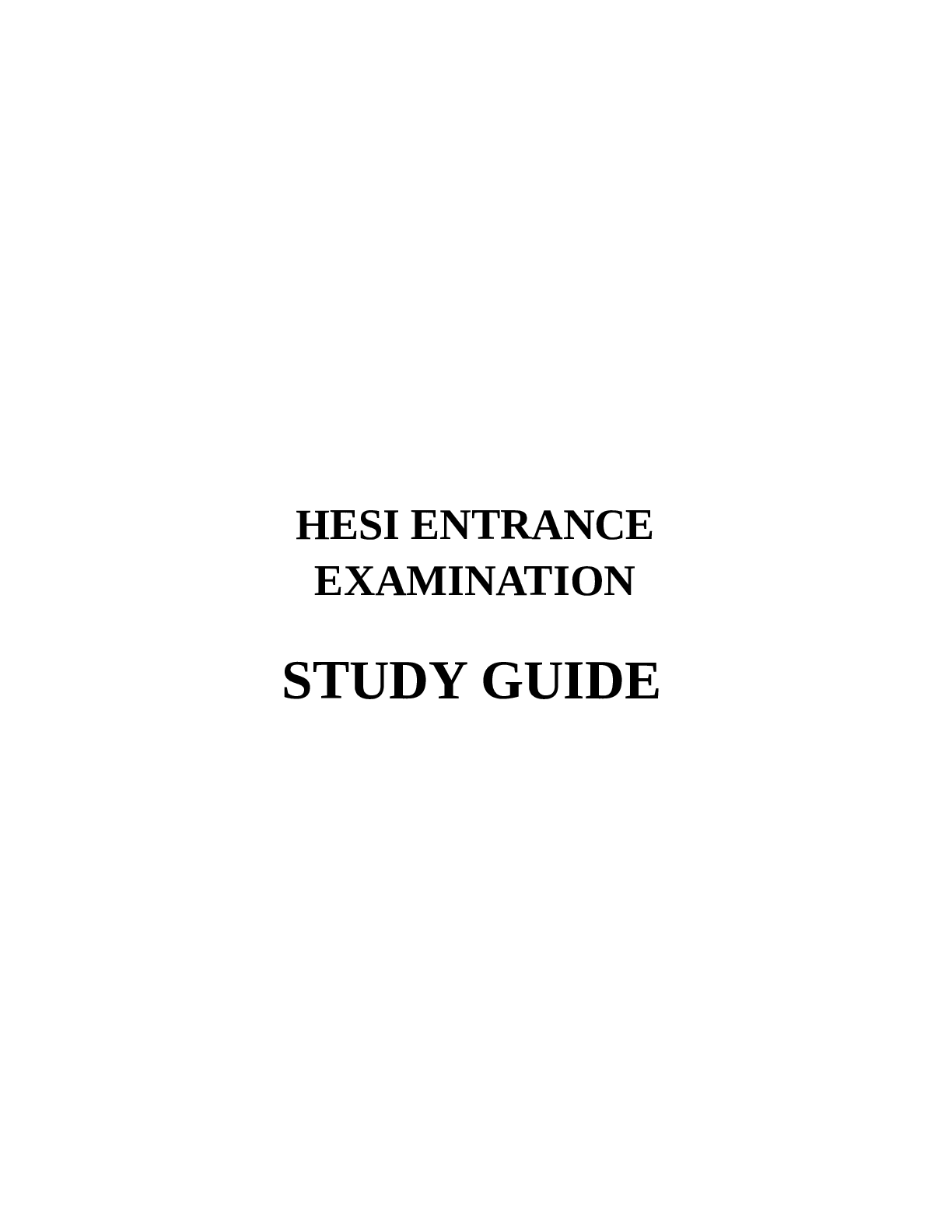
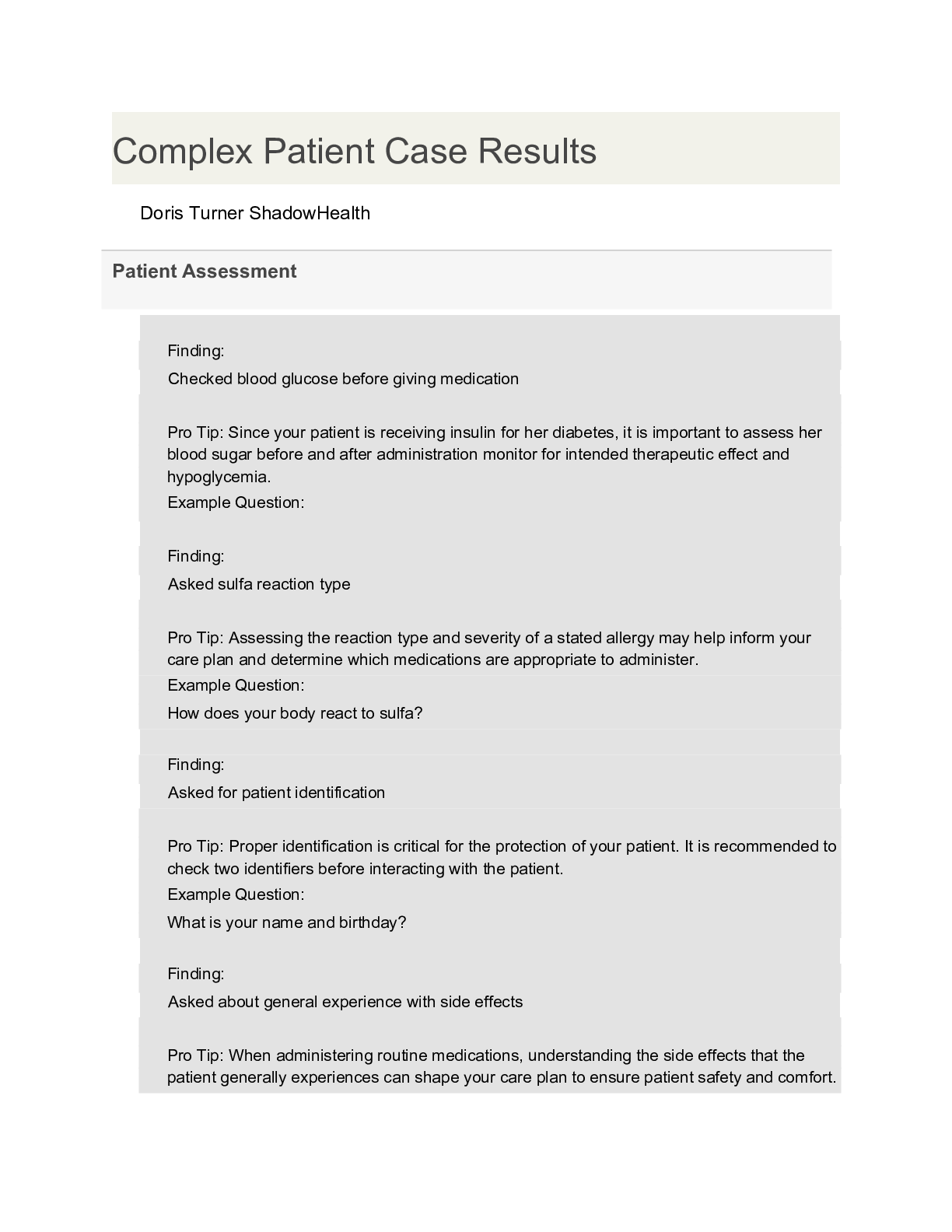

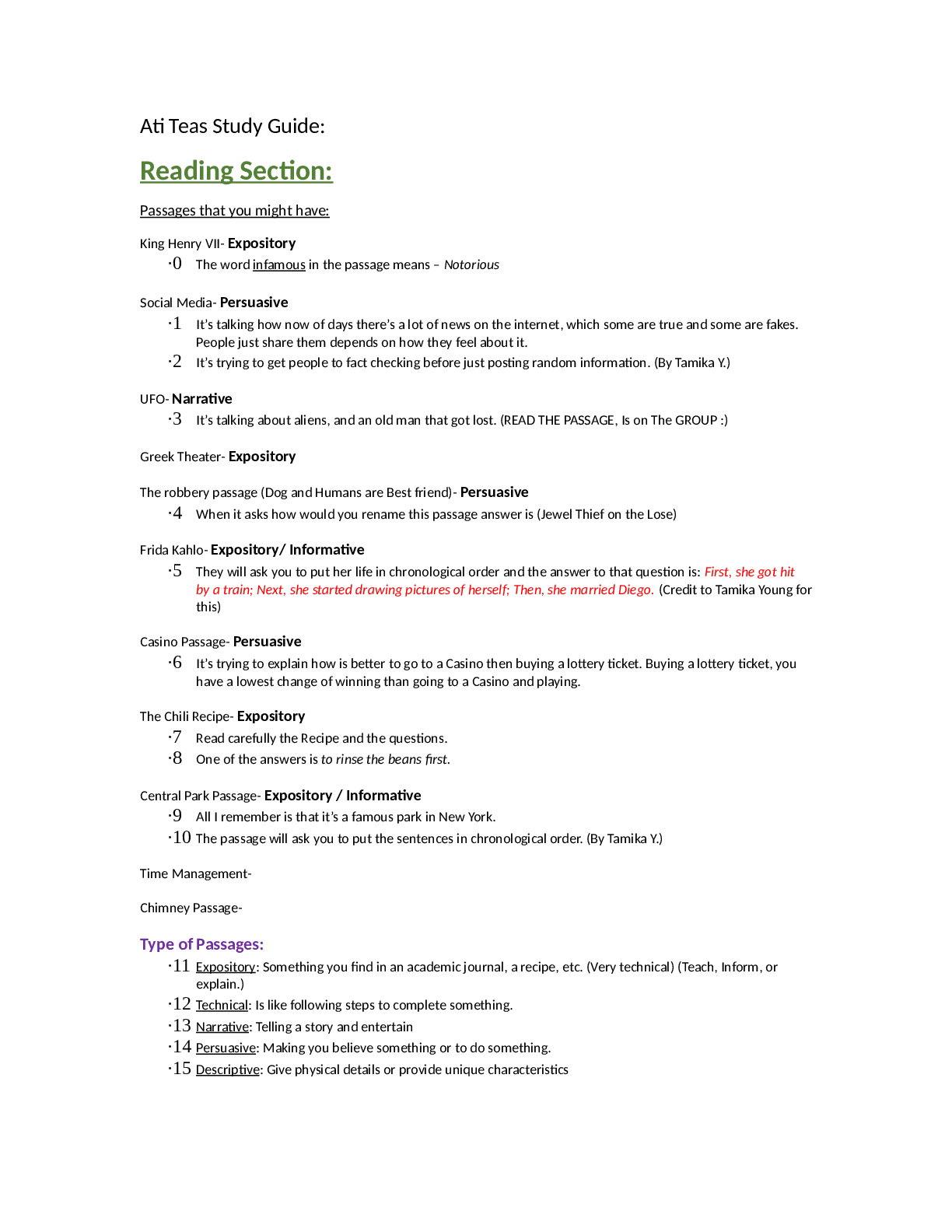
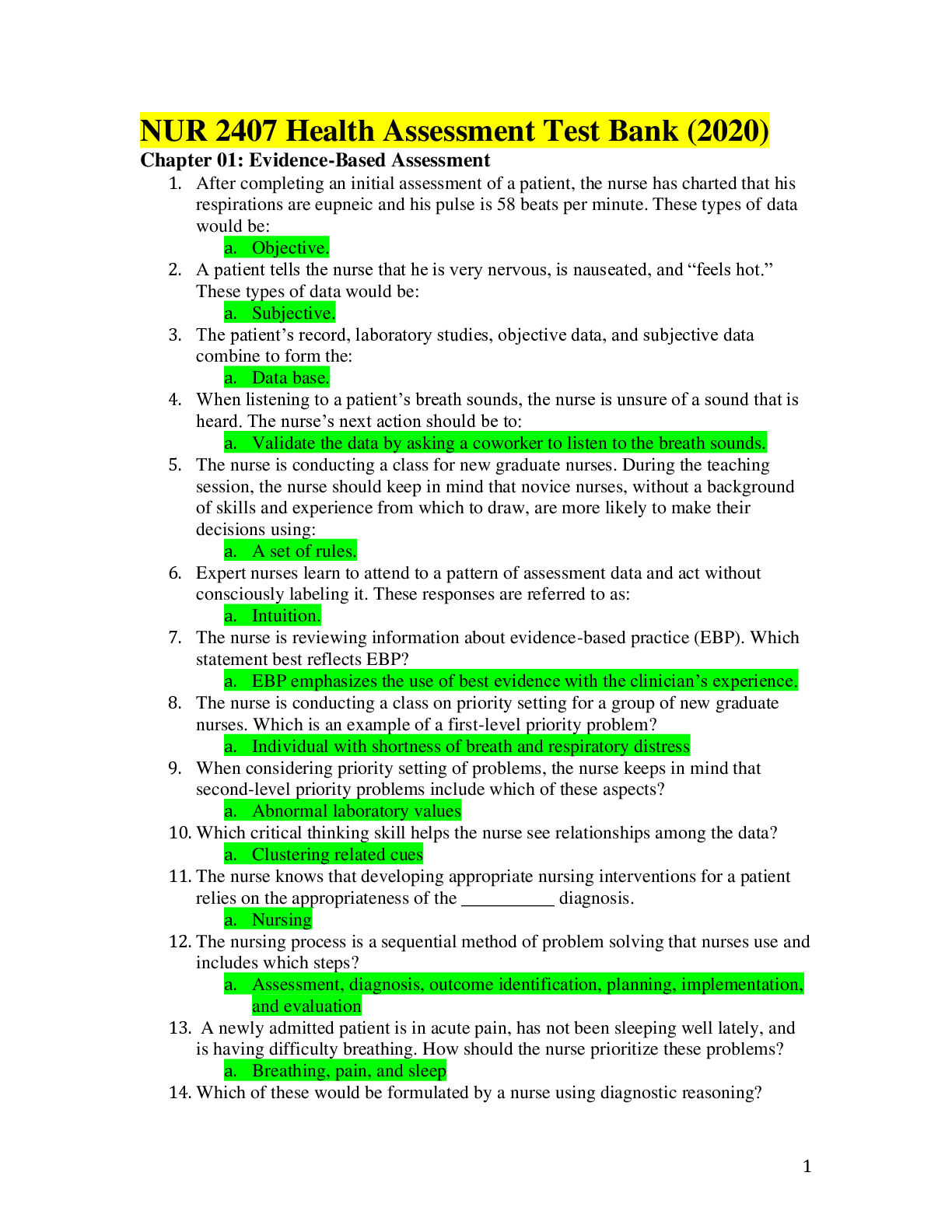

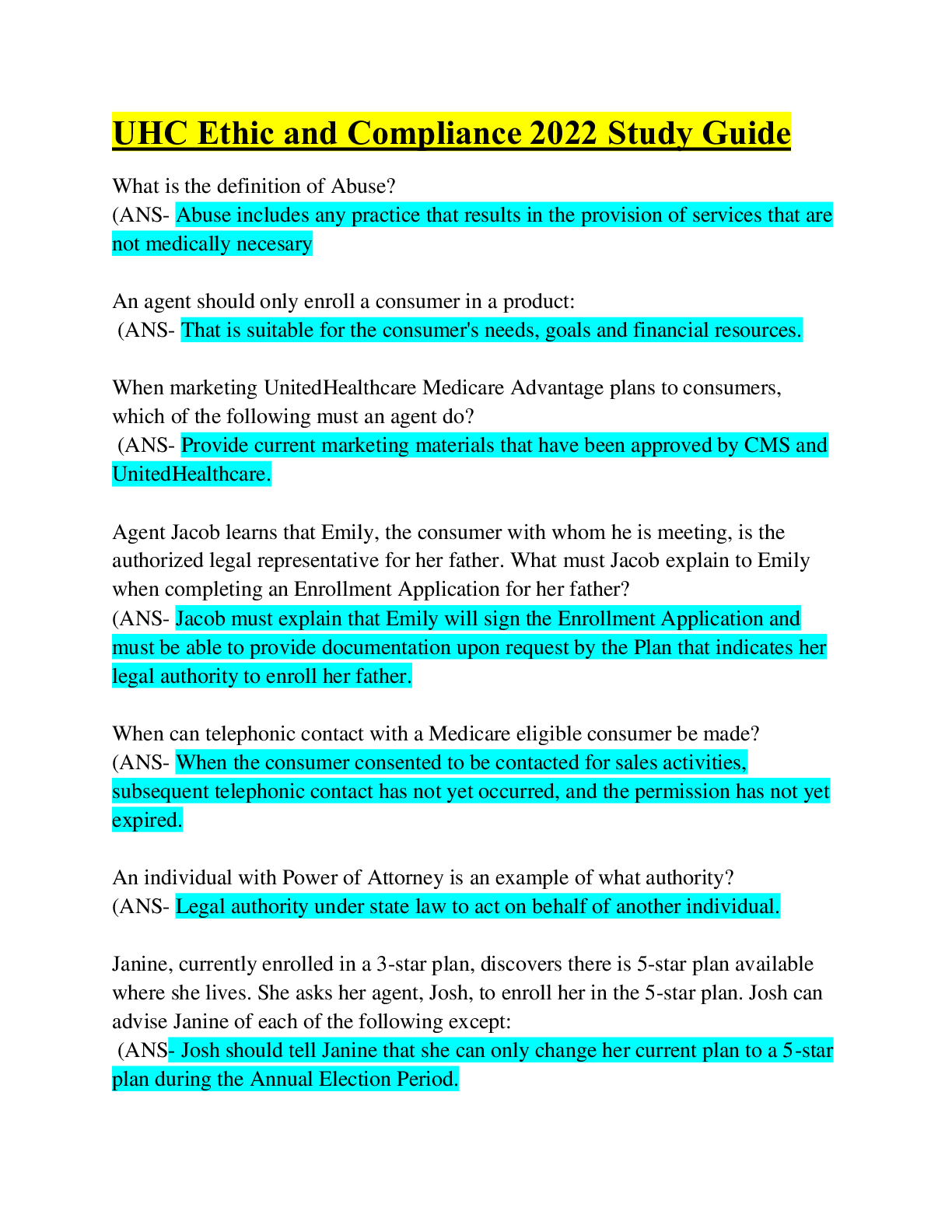
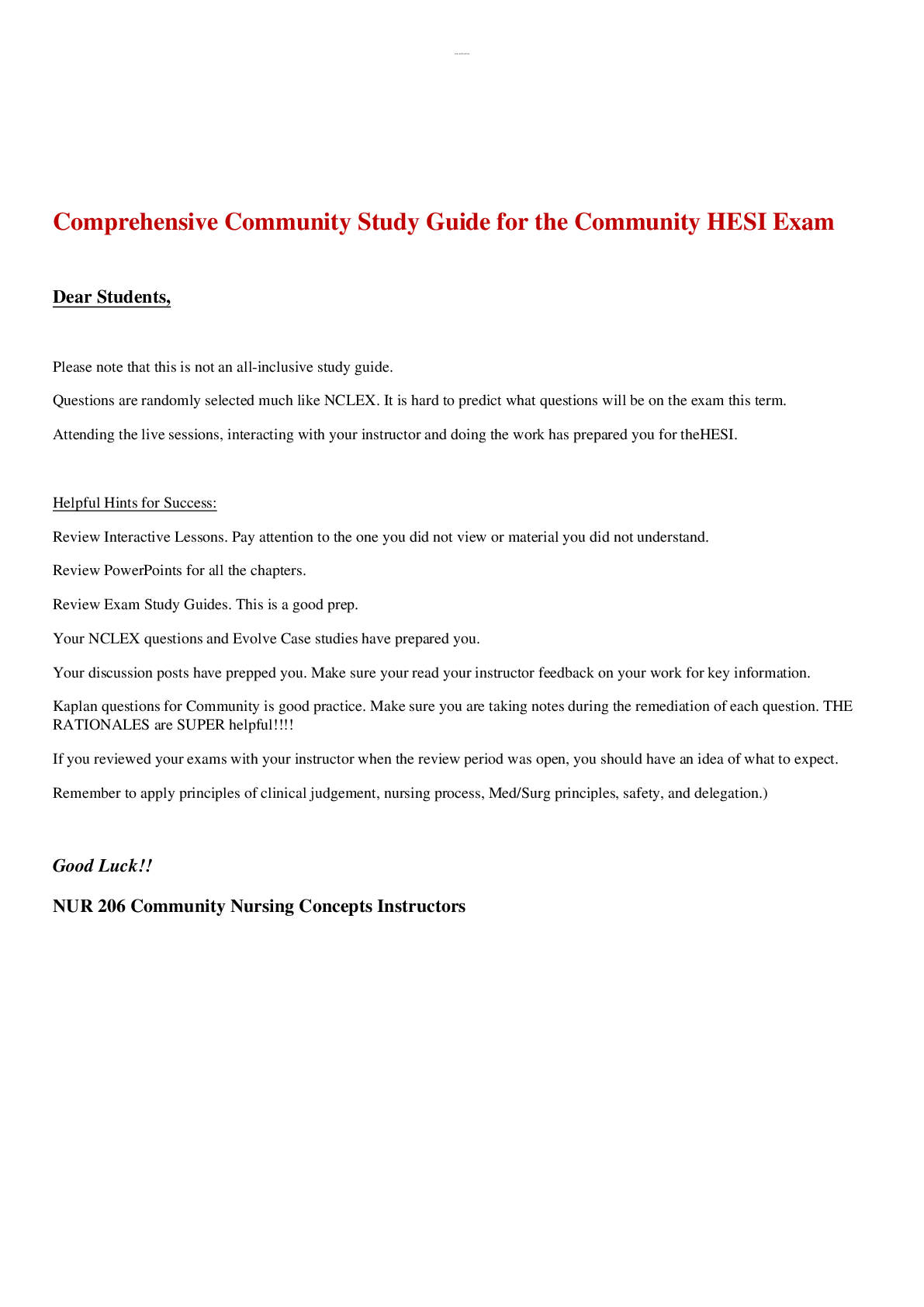
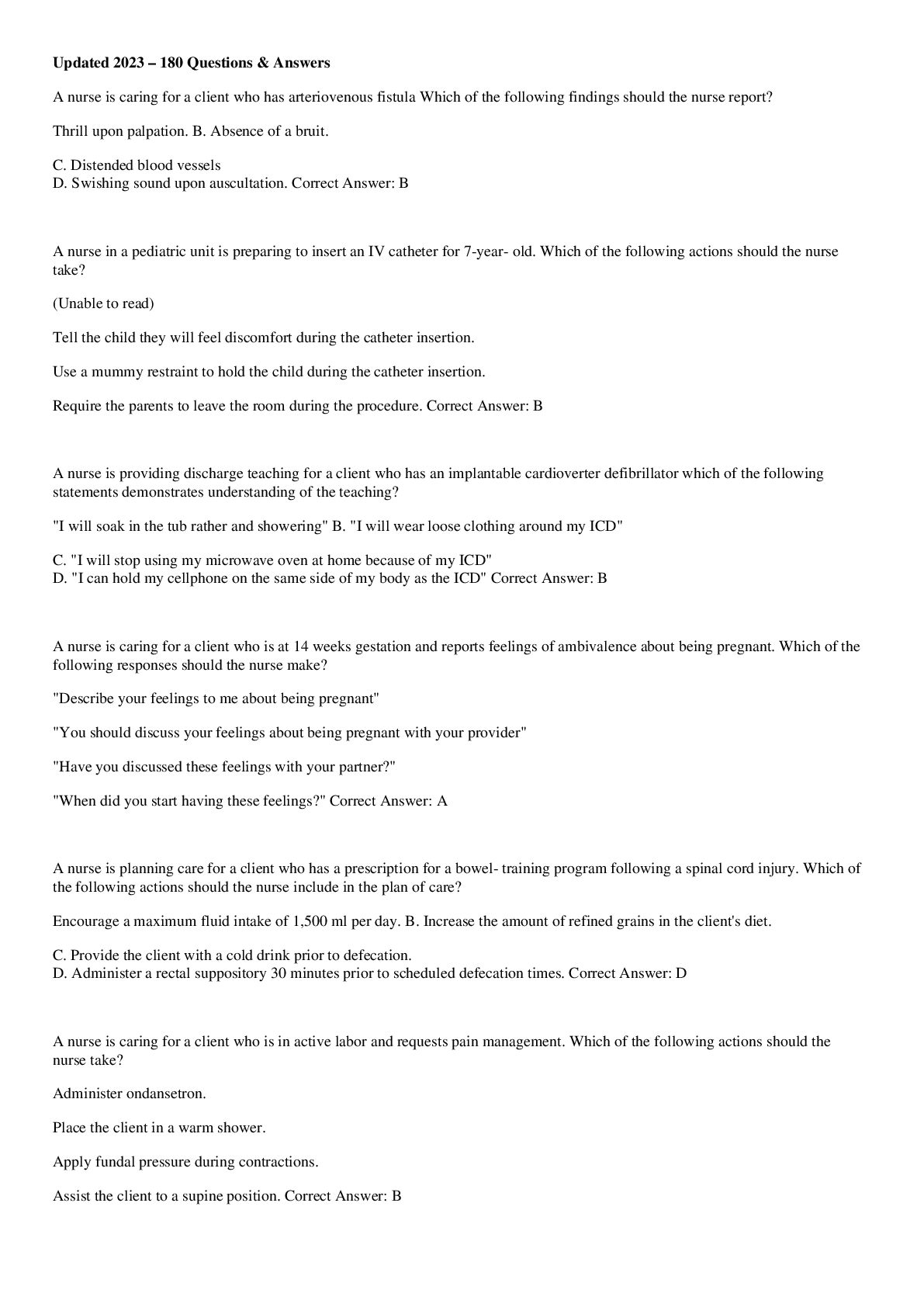
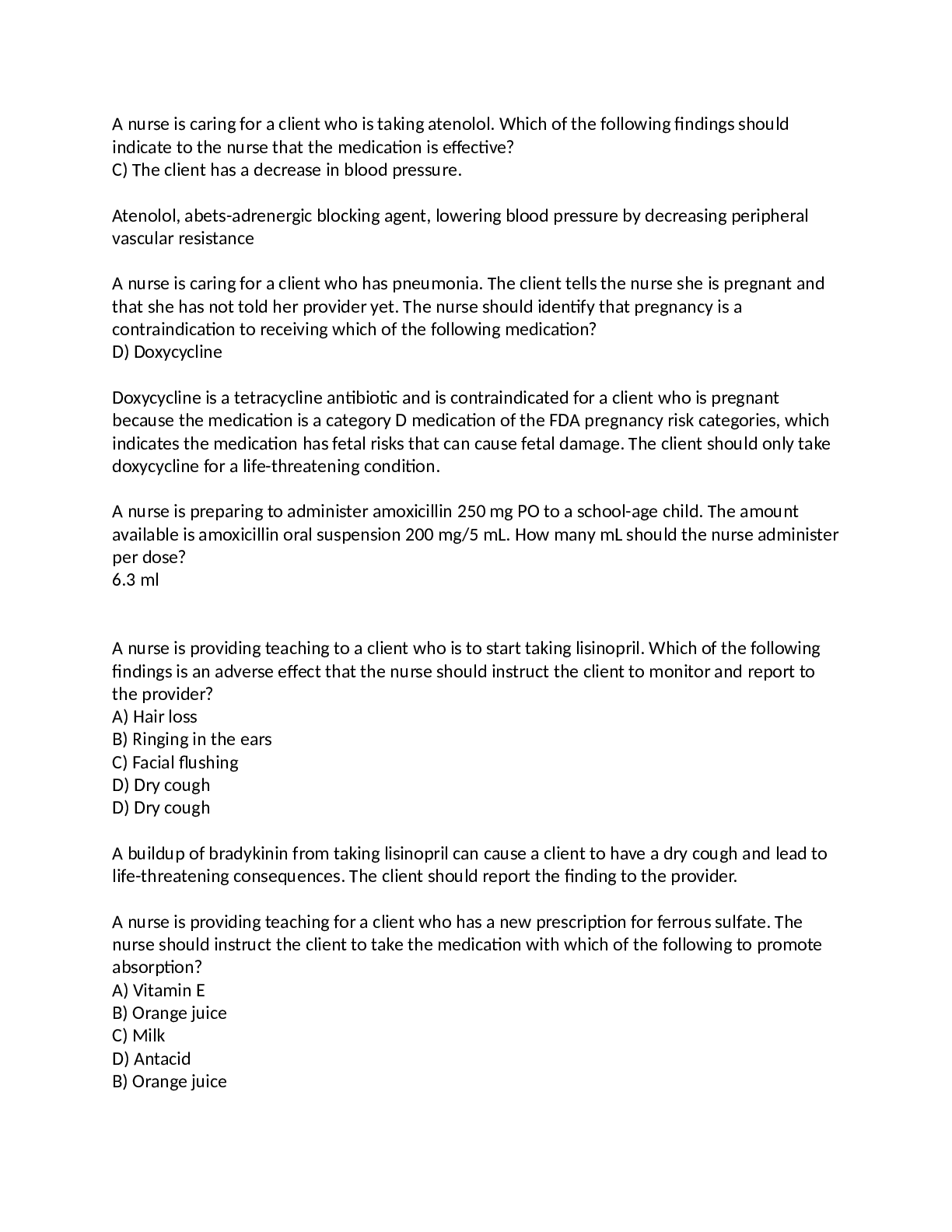

.png)
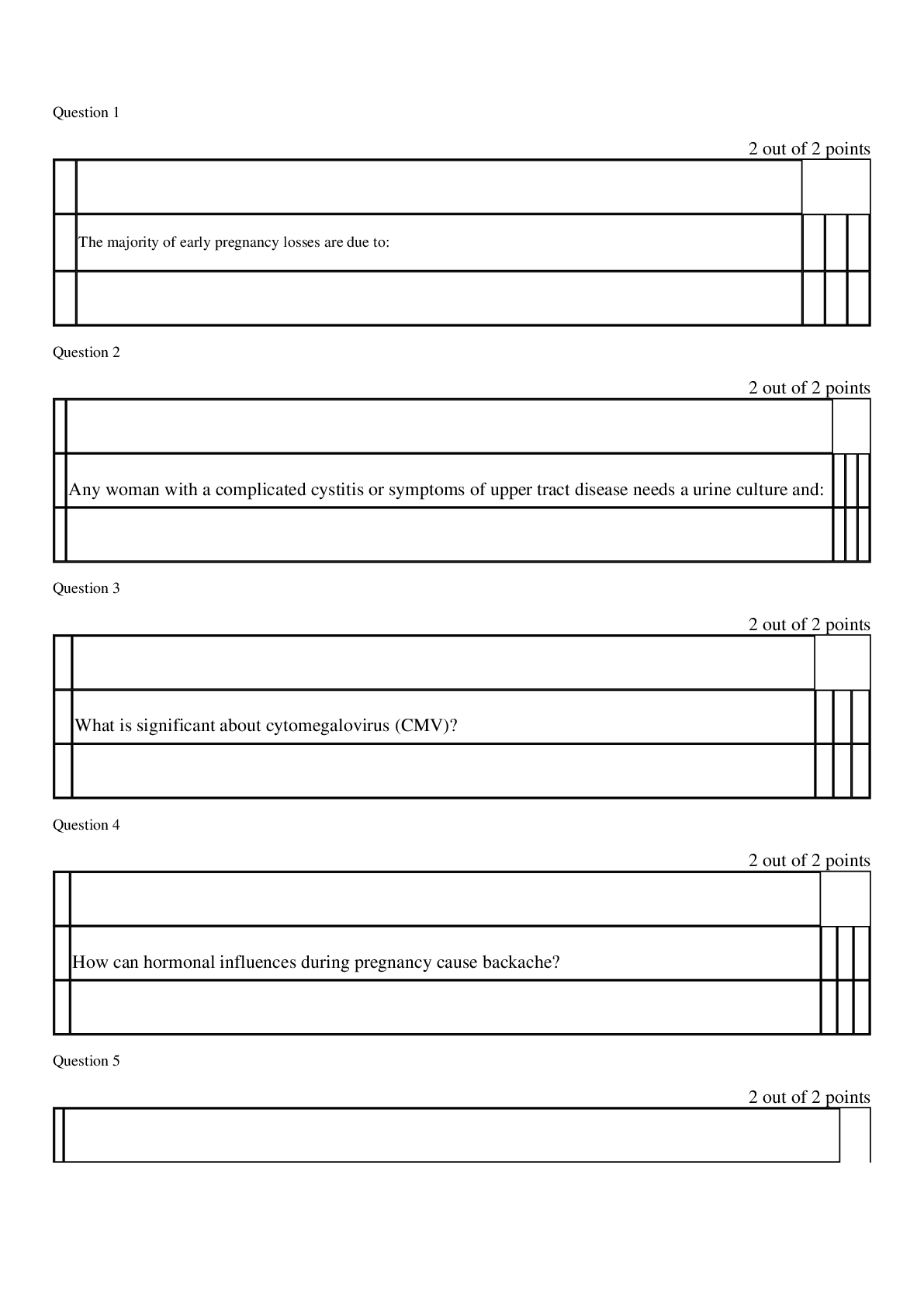

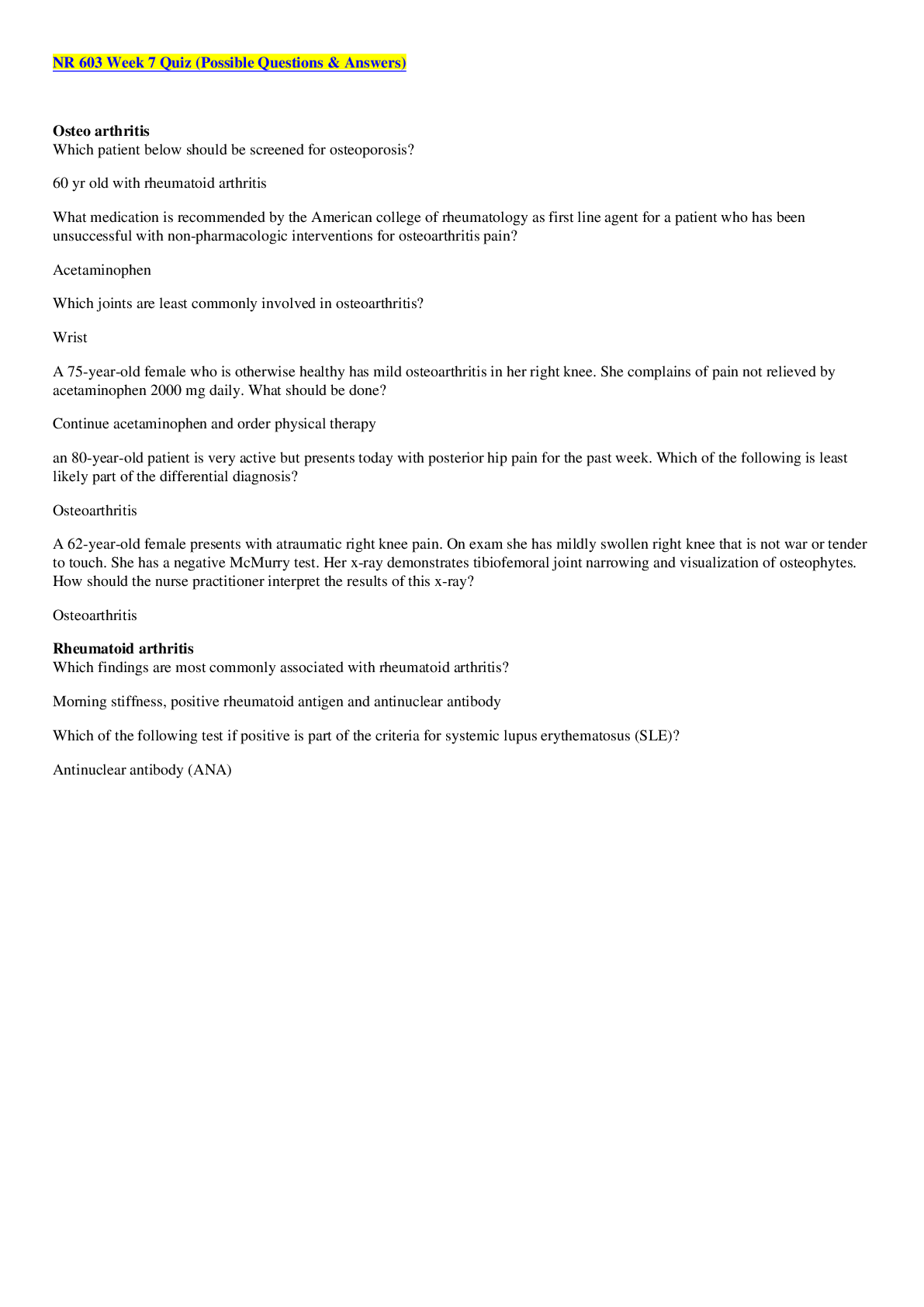
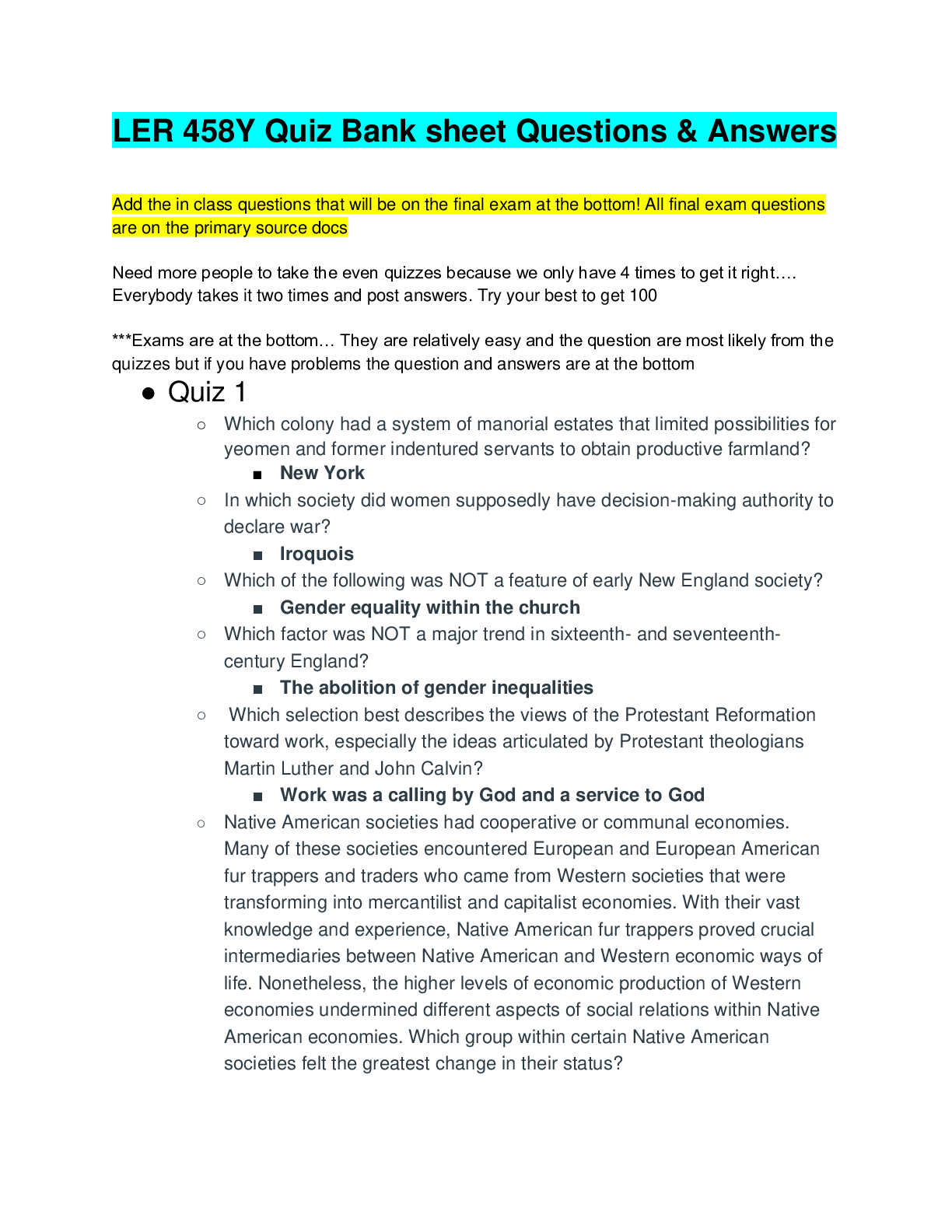
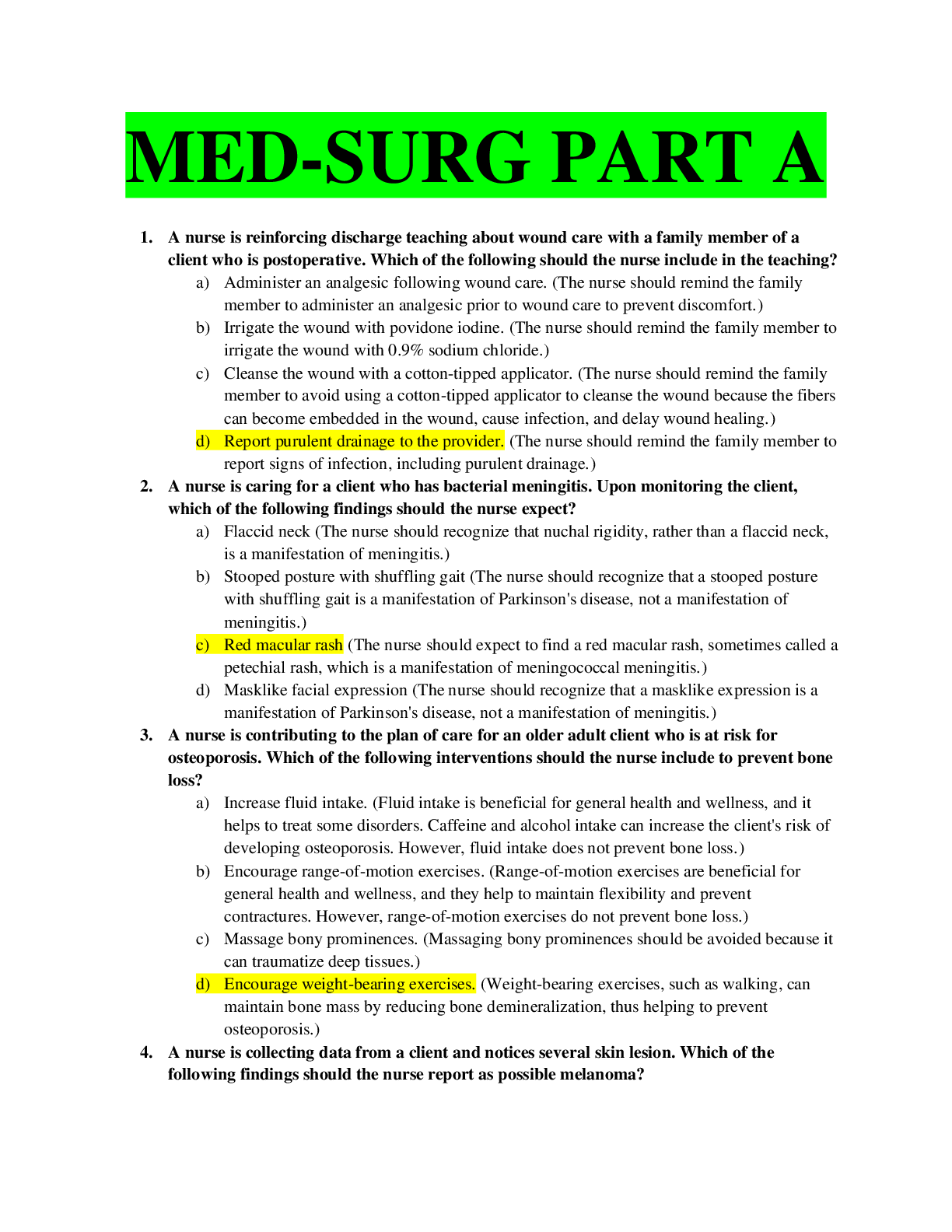
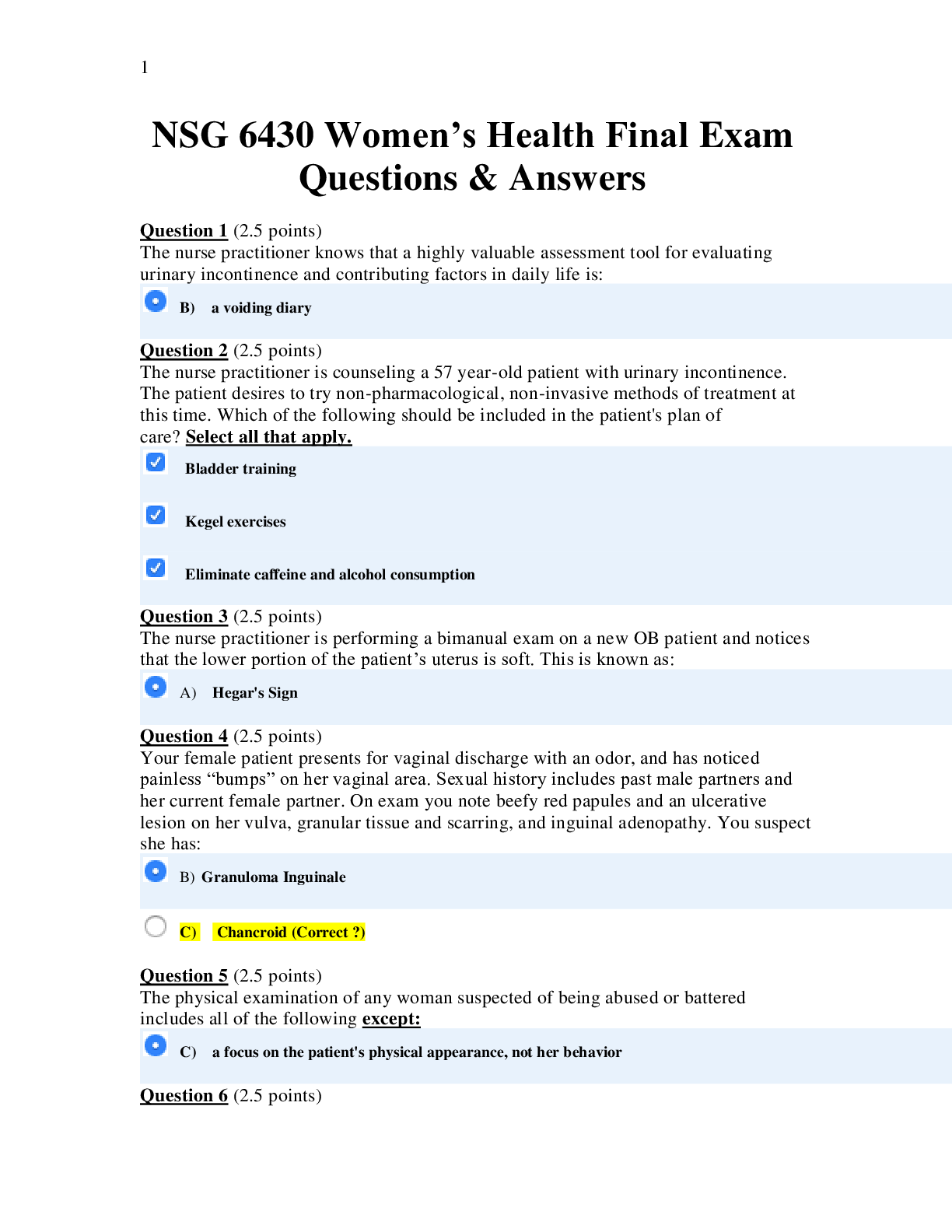
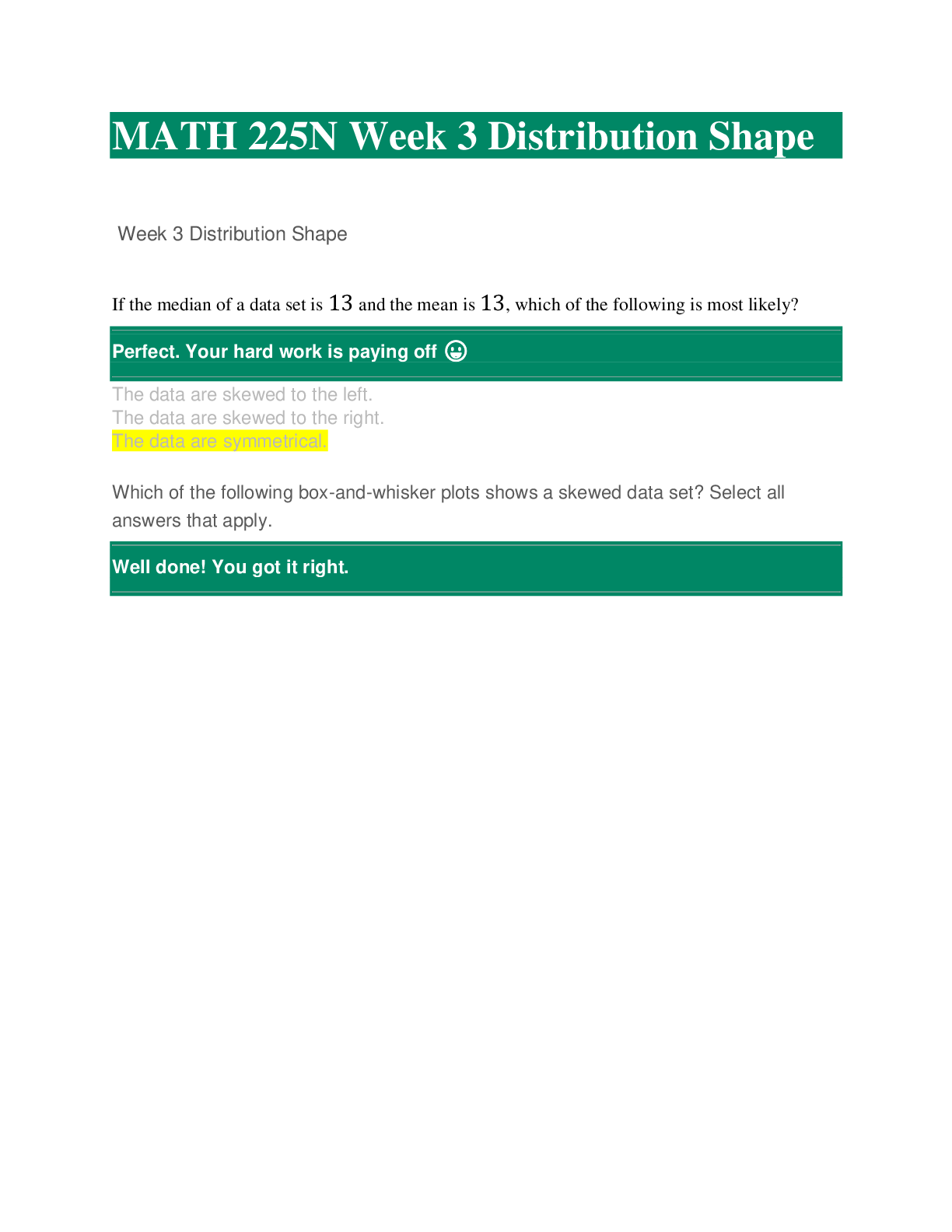
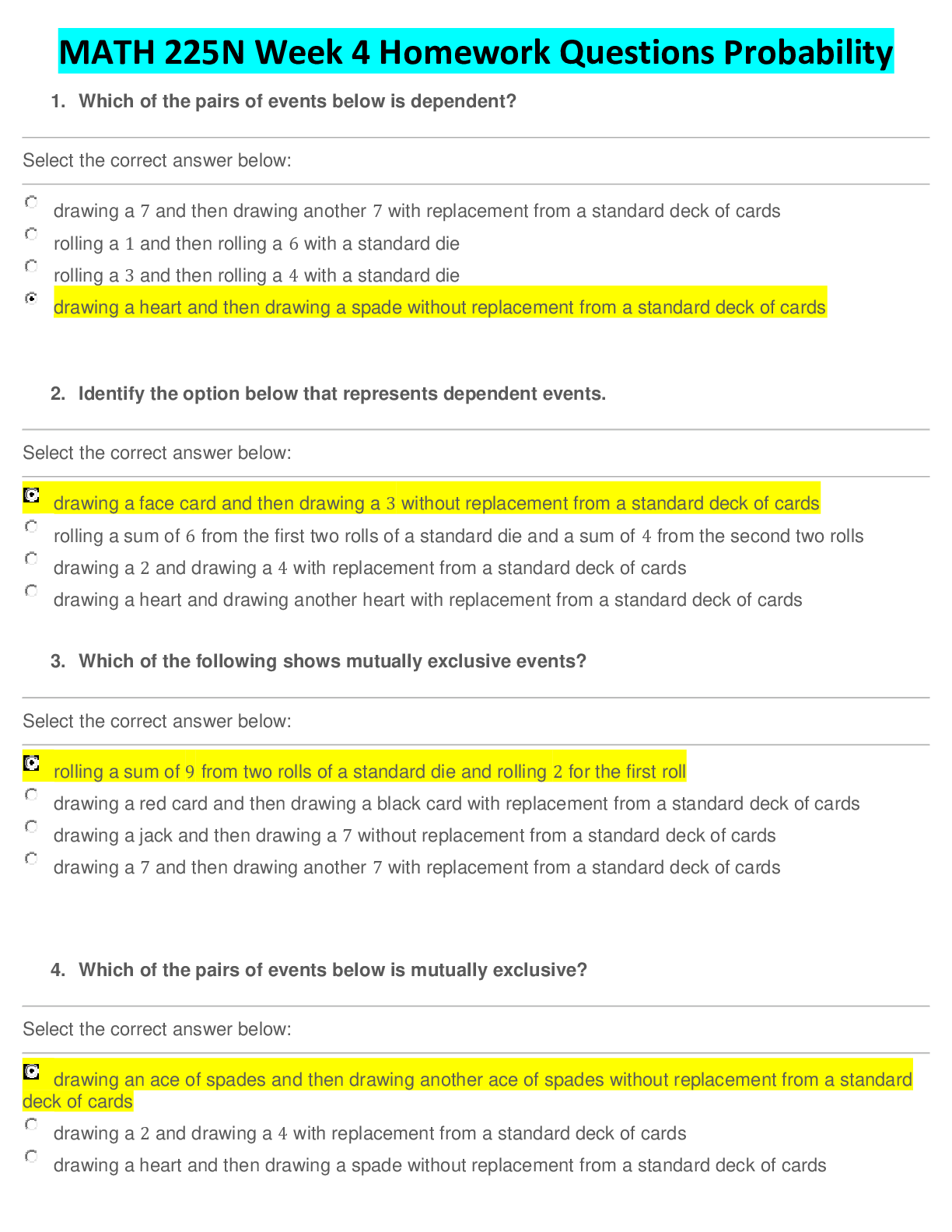
 Study Guide Latest 2022.png)
